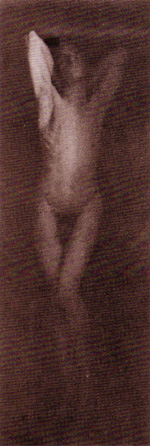
As you see, I'm
no longer able to stand alone;
but, some nights I have a dream.
I stand, young and naked, in front of
Fred's camera again.
Both my elbows
extend overhead. A cuttlefish
swims by. I raise my face; and,
slowly, beginning with my eyes and feet, I
dissolve into its
inky trail . . . .
O my, . . .
There I go again! Where were we . . . ? Yes.
Yes.... I've managed to pull a few
things together for you. Fred's parents. Yes,
very nice looking.
They ran the tannery
here at Norwood; they were well-to-do.
Victorians. Unitarians.
I remember them both very well; we
called her Lady Day.
There should also be
a photograph of Fred here . . . somewhere . . .
one of him back when he was
little tyke. Here it is; yes, that's him. He
couldn't have been more
than five or six when
that was made. Cutie Patootie, all
ears and gray melancholy
eyes. Here's another that might interest you.
I would call it
the Old Bullard Farm.
You don't recognize it? Well, you've been
there. It's what you're calling
the Old Day Place. Yes; yes, it's always been
a beautiful place. It
originally
was an Edwardian house with
a mansard roof and shutters.
I can remember when they refurbished it;
redid it Tudor
and equipped it
with electricity and modern
conveniences. Let me see,
that would've been in '90 ... or '91.
These are a couple
of journals I used
to subscribe to. Goodness! October,
1897. It
was the first one to pick up Fred.
Interesting, isn't it?
As you can
imagine, for those days it was . . . What
would be the word? . . . radical.
What did they go with? . . . Ethiopian.
Suitable. The model
was Fred's chauffeur,
Alfred Tanneyhill. Fred made some
astounding pictures of him.
What was it Fred called it? His. . . African... no --
Nubian -- yes, yes,
that was it, his
Nubian -- Series. This ended up
in Stieglitz's collection. Let's
see: July, 1898. At one time,
I had a print of this.
I thought it was
really somethin' -- the way his right arm
and left leg are like Vs
going in opposite directions. May I? ...
For a moment....
Joseph Kiley (I
have no idea who Mr. Kiley
is -- or was): . . . "exquisitely
harmonious". . . . Here; Fred particularly
liked this part, "...In its
conception it is
distinctly Greek, indeed, it has but
one fault that I can mention:
the little ivory statuette is in
too high a key of
white for the subdued
tones of the balance of the picture."
Fred felt that photography
was a facing up or back to something,
a kind of facing
something divine.
A kind of "instancy of revelation"
he called it. And, boy,
did he ever know how to create a public
stir! You know he was
the first American
artist to ever exhibit a full
frontal nude. A sepia.
In Boston. I posed for it. It was a study
for the Crucifixion.
One critic said it
was "free of that look that makes most
photographs of this sort
merely indecent." Fred was interested in
presence. Oh, he was
interested in all
sorts of things. Your coming here today
has been such a pleasure. I
can't begin to tell you how delightful it
is to find someone
like you interested
in our ... explorations of originality.
You could look up that sepia.
You may find . . . that you'll want to come visit
me again. But now,
if you'll excuse me,
I'd better get back to my place. I
imagine it's best before
dinner, that I lie down awhile, rest these old
weary bones a spell.
F. Holland Day was the first fine art photographer in America to include in a public exhibit a print of a full frontal male nude ("Study for the Crucifixion," March 1898, Boston).

